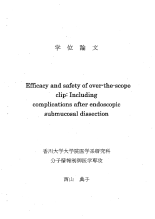Efficacy and safety of over-the-scope clip : including complications after endos
Access this Article
Author
Bibliographic Information
- Title
-
Efficacy and safety of over-the-scope clip : including complications after endos
- Author
-
西山, 典子
- University
-
香川大学
- Types of degree
-
博士(医学)
- Grant ID
-
甲第626号
- Degree year
-
2016-03-24
Note and Description
AIM: To retrospectively review the results of over-the-scope clip (OTSC) use in our hospital and to examine the feasibility of using the OTSC to treat perforations after endoscopic submucosal dissection (ESD).
METHODS: We enrolled 23 patients who presented with gastrointestinal (GI) bleeding, fistulae and perforations and were treated with OTSCs (Ovesco Endoscopy GmbH, Tuebingen, Germany) between November 2011 and September 2012. Maximum lesion size was defined as lesion diameter. The number of OTSCs to be used per patient was not decided until the lesion was completely closed. We used a twin grasper (Ovesco Endoscopy GmbH, Tuebingen, Germany) as a grasping device for all the patients. A 9 mm OTSC was chosen for use in the esophagus and colon, and a 10 mm device was used for the stomach, duodenum and rectum. The overall success rate and complications were evaluated, with a particular emphasis on patients who had undergone ESD due to adenocarcinoma. In technical successful cases we included not only complete closing by using OTSCs, but also partial closing where complete closure with OTSCs is almost difficult. In overall clinical successful cases we included only complete closing by using only OTSCs perfectly. All the OTSCs were placed by 2 experienced endoscopists. The sites closed after ESD included not only the perforation site but also all defective ulcers sites.
RESULTS: A total of 23 patients [mean age 77 years (range 64-98 years)] underwent OTSC placement during the study period. The indications for OTSC placement were GI bleeding (n = 9), perforation (n = 10), fistula (n = 4) and the prevention of post-ESD duodenal artificial ulcer perforation (n = 1). One patient had a perforation caused by a glycerin enema, after which a fistula formed. Lesion closure using the OTSC alone was successful in 19 out of 23 patients, and overall success rate was 82.6%. A large lesion size (greater than 20 mm) and a delayed diagnosis (more than 1 wk) were the major contributing factors for the overall unsuccessful clinical cases. The location of the unsuccessful lesion was in the stomach. The median operation time in the successful cases was 18 min, and the average observation time was 67 d. During the observation period, none of the patients experienced any complications associated with OTSC placement. In addition, we successfully used the OTSC to close the perforation site after ESD in 6 patients. This was a single-center, retrospective study with a small sample size.
CONCLUSION: The OTSC is effective for treating GI bleeding, fistulae as well as perforations, and the OTSC technique proofed effective treatment for perforation after ESD.

